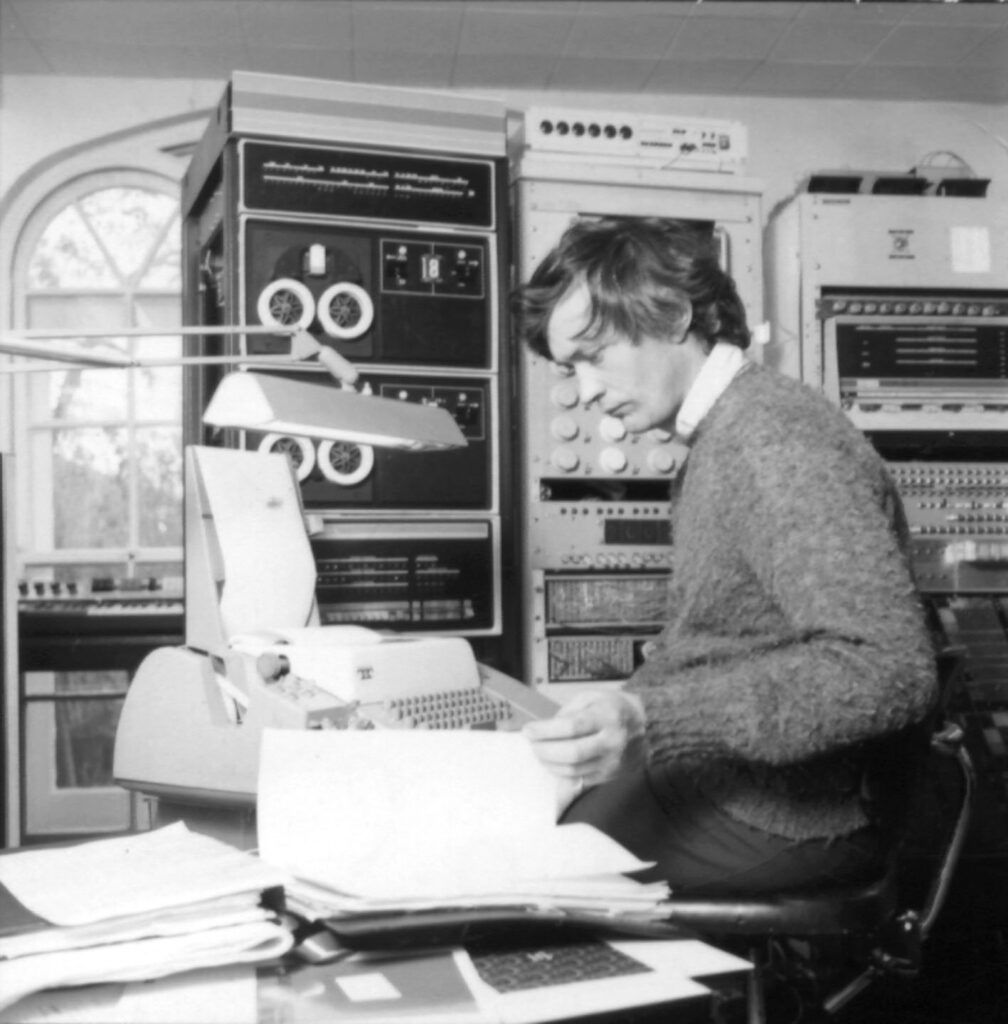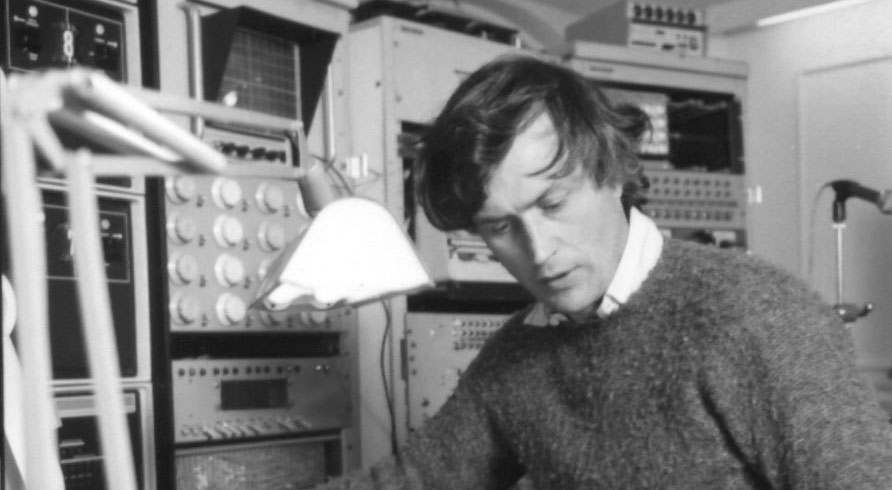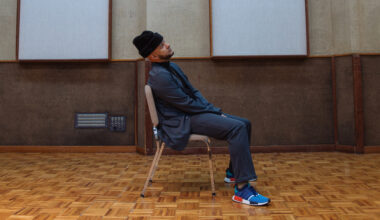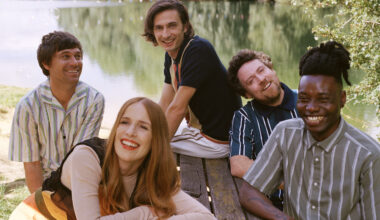Dr Peter Zinovieff is responsible for the first British synthesiser, the VCS3. Now in his 80s, he remains as interested in the future as ever. And he’s invited us to lunch, to discuss Kraftwerk, Robert Moog, Delia Derbyshire, a couple of Beatles, hard drives costing £4,000 and a computer powered by a windmill
“Kraftwerk? Yes, they did come and visit. They were very nice, but I don’t remember much about them to be honest. I did teach Ringo Starr how to use his VCS3. I would go to his house in Hampstead and show him the VCS3 while his kids were playing in the garden. That was very nice.”
Dr Peter Zinovieff, inventor and composer, father of the British synthesiser and the man responsible for the first commercial computer sequencer, chuckles at the memory of his interaction with The Beatles.
The reason I’m here at Peter Zinovieff’s home in Cambridge is ostensibly to talk about a new double CD retrospective of his early electronic compositions. ‘Electronic Calendar’ is being released by Space Age Recordings, the label run by Pete Kember (aka Sonic Boom, once of Spacemen 3, now an experimental music curator). It’s a suitably lavish package, the extensive liner notes running to some 60-odd pages and bookended by the two CDs. But it soon becomes clear that speaking to Zinovieff isn’t going to be your standard artist-has-new-album chat. For a start, my interview request has resulted in an invitation to lunch. As the tape machine rolls, we enjoy some enormous prawns and a couscous salad.
And asking Zinovieff about the album results in elliptical observations about the nature of computer coding and the iPad version of the VCS3 synth, the original of which was launched in 1969 by his company, Electronic Music Studios (London) Limited, better known as EMS. We also discuss Beethoven, Paul McCartney, Delia Derbyshire and Robert Moog.
“I remember Robert Moog being on the floor at EMS in Putney with the VCS3, rather captivated and a bit amazed,” he tells me. “Later on, he nearly went broke and we tried to buy his company for $100,000. We weren’t able to raise the money, but we very nearly joined forces…”
Now there’s a tantalising scenario to mull over.
As our lunch continues, we chat a bit more about ‘Electronic Calendar’. The album seems to be a slightly mysterious artefact to Peter Zinovieff.
“I don’t know much about it,” he says with amused otherwordly bewilderment. “It just arrived in the post one day. Jenny [his partner] opened it up and read the first sentence of the booklet [‘No sleeve notes or musicological diatribes can possibly describe or sum up the genius encapsulated in the work of Peter Zinovieff and EMS’]. Well, that was great! I just hope that no one from Deutsche Grammaphon is going to object.”
He’s slightly worried about copyright clearance from the esteemed German classical music label, which first released his collaborations with Harrison Birtwistle and Hans Werner Henze in the 1960s. At the time, Zinovieff was part of a small but significant movement of composers, which also included Tristram Cary and Daphne Oram, who were stretching the classical music establishment’s ability to cope with new ideas by melding it with avant-garde electronics and demanding it be taken seriously. At a famous concert at the Queen Elizabeth Hall in London in 1968, Tristram Cary presented one of Zinovieff’s computer music works called ‘Partita For Unattended Computer’. An enormous computer sat alone on the stage and spat out a composition of its own making, defined by parameters programmed in by Zinovieff. The reviews of the sell-out performance were, it’s fair to say, mixed.
Zinovieff, however, despite his post-war Oxford University demeanour and his background as the son of Russian émigrés (they left Russia in a hurry during the revolution and later met in London), isn’t po-faced about his serious music. One of the most telling tracks on the album, for example, is ‘Lollipop For Papa’, a reference to the composer Haydn, which starts like a conventional Wendy Carlos-esque classical-on-synths piece, the sounds generated by blipping oscillators, and is then pushed through a series of increasingly abstract variations until it ends up as a swirl of electronics, swamped in reverb.
It sounds like what might happen when a score made up of classically organised tones is fed into a computer to be analysed and re-organised along new digital lines – because that’s exactly what it is. See, there’s Haydn with a lollipop in his mouth, grinning delightedly at a computer playing his own music back at him. But the composer of the ‘Surprise Symphony’, which shocked audiences out of their seats in 1792 with a huge and unexpected crashing orchestral chord in the middle of a quiet piano part, would surely have appreciated Zinovieff’s cheek. The conceit of communicating with the great composers is an idea Zinovieff has pursued again more recently with a piece called ‘Good Morning Ludwig’, a version of which he is finessing for an imminent visit to Japan as I arrive at his house.
“It’s an imaginary conversation with Beethoven,” he explains with an impish laugh. “I did computer variations on some Beethoven music and for each variation I had this conversation: ‘Well Ludwig, what would you think if I put the cellos up here and only play every other note?’ or whatever. Of course, the difficulty was to get poor Beethoven to understand what a loudspeaker was. That was a terrible shock to him.”
‘Good Morning Ludwig’ was first commissioned by TBA21, an international arts foundation headed up by Francesca von Habsburg, an alumni of St Martin’s whose own family has long been very wealthy patrons of the arts. Yes, we’re talking the von Habsburg family, Francesca’s husband being the son of the last crown prince of Austria-Hungary. The piece was written to be played through TBA21’s Morning Line, an audio system cum huge sculpture which is designed to project sound into specific areas, creating a spatial experience of the music.
This rarified world of academic classical music and high art, an alternative jet stream of monied patrons and international art biennials, is the one that Peter Zinovieff inhabits. It’s a place where reissues of old material on boutique record labels, while delightful, aren’t especially important. It’s also a place that doesn’t mean much to most people who are interested in Zinovieff, though. It’s his role as the inventor of the much-loved VCS3 and EMS’s other synths that excites the electronic music community.
With the prawns and the couscous eaten, we move to a downstairs room where Zinovieff sits with two large computer screens in front of him. He tells me he’s currently beta testing Windows 10 (“It’s very good, lovely in fact,” he says). He has a stack of hard drives in the room, totalling some 30 or 40 terabytes of storage, mostly for his extensive sample libraries. These days, of course, you can buy a terabyte of space from Tesco for less than £50. It’s a far cry from his first hard drive, which he purchased for EMS in the 1960s.
“It was huge and it cost £4,000 for 32K,” he remembers. “Sometimes we’d have to take the lid off and wipe it because the dust would get in.”

At the time, EMS was the only privately owned computer music studio in the UK, probably the only one in the world. Although there were other electronic music studios, they were pretty thin on the ground and almost all of them were owned and run by national broadcasting corporations: RTF’s Paris studio, which opened in the late 1940s with Pierres Schaeffer and Henry exploring tape music, and WDR’s Cologne studio, where Stockhausen could often be found alongside Herbert Eimert in the 1950s. And then there was also the BBC’s Radiophonic Workshop.
Zinovieff teamed up with the Workshop’s Brian Hodgsonand Delia Derbyshire in the mid-60s for an outfit they called Unit Delta Plus. The idea was to create commercial electronic music in Zinovieff’s studio, cranking out tracks for TV ads and the like for cash. It lasted less than a year and wasn’t a great success. But Delia Derbyshire remains the poster girl for British electronic music, mainly thanks to her work on the ‘Doctor Who’ theme. It was Pete Kember who was responsible for coaxing her out of retirement towards the end of her life.
“He worked with her a lot,” says Zinovieff. “He was her greatest aficionado. He got her this curious status which she has now. Almost everybody asks me, ‘What was your relationship with Delia Derbyshire?’. I recently had a list of questions from a Japanese magazine that asked, ‘What about the relationship with Delia Derbyshire and the wonderful, fabulous Unit Delta Plus?’. Well, the wonderful, fabulous Unit Delta Plus did absolutely nothing, except there’s that nice poster there…”
He indicates a framed poster on the wall for the Million Volt Rave at The Roundhouse in early 1967, where The Beatles’ legendary and still unreleased experimental track ‘The Carnival Of Light’ was played.
“What was done there is lost,” he says. “Unit Delta Plus did a tape piece and a little bit of a collaboration with Paul McCartney, but I think The Beatles’ mangers sort of suppressed it.”
Zinovieff is certainly better known for his legacy of synthesisers than for the music he has composed. But EMS, which he started with Tristram Cary and electronics genius David Cockerell (who went on to design the Akai sampler in the 1980s), was established less out of a passion for synths and more as a way of funding his studio, where he could continue to investigate the outer limits of electronic circuitry’s relationship to music. So it’s perhaps curious that many synthesiser enthusiasts now consider the machines that EMS produced to be more desirable than any other vintage kit.
Maybe it’s their very British eccentricity that makes them so compelling. Maybe it’s their close association with the Radiophonic Workshop, Eno and Pink Floyd. Whatever it is, EMS’s quirky and strange machines went from the sublime (the VCS3 and the Synthi AKS, both affordable, usable and fun music making machines) to the ridiculous (the Synthi 100, a massive room-filling beast that cost more money than most people would see in a lifetime) – and everything in between.
The tension at the heart of EMS, which would eventually contribute to the company’s demise at the end of the 1970s, was between the commercial pressures to make gear that would sell in sufficient numbers and Zinovieff’s own single-minded interest in the application of computers in making music, the purity of the life of an avant-garde composer, pursuing ideas for their own sake.
“I think anybody would have been interested in this new field, let alone innovative people like The Beatles, who were always open and friendly,” he says of these pioneering years. “It said you could do anything, you could think of a sound and then make it. How could people not be interested? It promised so much, but it wasn’t able to achieve those promises. Then there was a bit of a fizzle out and it was mainly due to the synthesisers, because synths said, ‘Alright, here it is, it’s all self-contained, this is what you can do’, so there wasn’t really any reason to have great junk yards like this…”
He points at another framed picture on the wall, a photograph of EMS in the late 1960s, a room filled with intimidating machinery. I ask him if he feels that by simplifying the ideas of the studio and building them into a synth, it almost stunted experimentation?
“I think so, yes, because then there was no real reason to have experimental studios. Everybody just thought, ‘I’ve got it all’.”
That’s ironic, isn’t it?
“I suppose. It was originally about making some money in order to keep experimenting, but it got ahead of itself. Unfortunately, manufacturing was the death of EMS. They tried to make us public in America. There were these huge sums of money involved, so we went broke, but it was the manufacturing that made us go broke, not the experiments. The terrible business world of charlatans in America… I mean, really fraudulent. We had a cheque from a bank in America which our bank here accepted and it turned out to be a fraud. Our bank said, ‘This was your collateral, so now you have to pay’. It was $150,000. That was the beginning of the end.”
A £40,000 investment in an Analytical Engine, the only piece of EMS gear that Zinovieff still owns (“If I still had a VCS3 or something, I would have sold it and bought a really good computer by now,” he shrugs), didn’t help the company’s financial health. Zinovieff says the Analytical Engine worked “for about two seconds”. After the collapse of EMS, the studio was kept at a National Theatre “storage dungeon”, supposedly awaiting installation as a national asset, but it ended up being destroyed as a result of flooding and negligence.
Zinovieff subsequently moved to the island of Rasaay off the west coast of Scotland with a PDP-8 computer and a filter bank, which he ran from electricity generated by a windmill. He was commissioned by Clive Sinclair to explore the possibilities of the ZX81 and had it controlling a piano via an array of solenoids. He later established and ran an electronic music studio at Cambridge University, but for the best part of two decades he remained out of public sight until starting to compose publicly again in 2010.
“There has been a lot of attention,” he concedes happily. “But it’s often slightly misjudged. What’s exciting is that the Royal College of Art and the Science Museum are funding a PhD on EMS. So although everyone has gone on about the VCS3 and Delia Derbyshire, what was really intriguing was the studio itself.”
Do you feel responsible for a generation electronic music lovers, who grew up with the sound of your machines ringing in their ears, thanks to the Radiophonic Workshop, Brian Eno, Pink Floyd, David Bowie, Hawkwind, Kraftwerk and all the rest?
“No,” replies Dr Peter Zinovieff, one of the 20th century’s visionary futurists. “But I always felt that the future was bright. I still do, so let’s see what’s going to happen next.”
‘Electronic Calendar’ is out on Space Age Recordings






